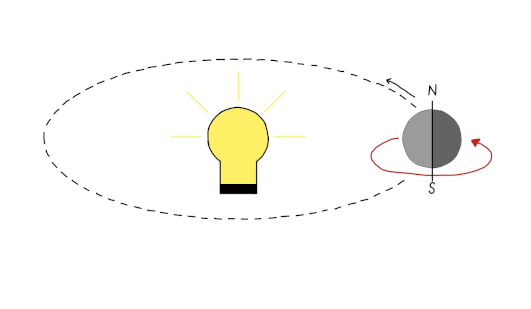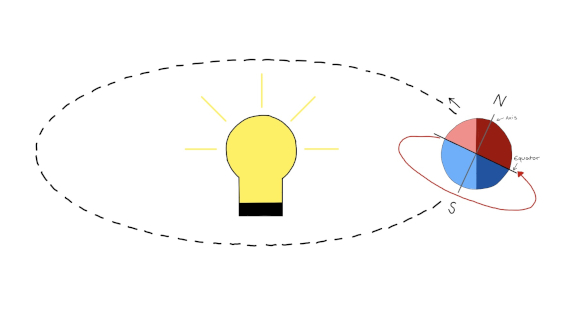While our earth takes one journey around the sun we live through different seasons, and they happen around the same time every year. Since the equator divides the planet into two different parts, our experience with weather can vary a lot. If you are interested in why Australians are excited for the “warm January”, then keep reading!

Why do we have seasons?
To understand the concept of changing seasons on our planet, you have to know that the earth’s axis (the line that connects the North and the South Pole) is tilted. At an angle of 23, 5° our axis sometimes points at the sun, and sometimes away from it. To visualize our journey around the sun, imagine a ball (our earth in this case) moving around a light bulb (our sun) in a circle. If you want to try this at home you can mark the North and South Poles and connect them with a line, representing the axis. While the ball moves in a circle around the light bulb it also simultaneously spins around its own axis. One circle around the light bulb represents one year and one spin of the ball around its axis represents one day. If you were to hold the ball straight, so that the axis is parallel to the sun, you would notice that most parts of the ball get the same amount of sunlight. Of course, the North and the South Poles get the least amount of sun, which is why these are the coldest parts of Earth. If the Earth would be moving like this, we wouldn’t have any seasons because the amount of sunlight we get would be the same all year round.

Now try colouring in the northern half and the southern half of the Earth in different colours. Let’s say the bottom half is blue and the upper half red. Let the ball travel around the light again but this time, hold it at an angle. The axis should now point more to one side rather than straight up. The hemisphere that is now tilted away from the bulb gets less light, and the hemisphere tilted towards it gets more. If the blue half gets more light, that means that it’s summer there and winter in the red half. This happens in the months of December, January and February. If you keep the ball at the same angle and move it to the other side of the circle, you will notice that now the red half gets more light than the blue side. This means it’s summer in the northern part and winter in the southern part.

To transfer this onto the seasons on earth imagine that the ball is standing still on the circle, but spins once around its axis. The lit-up part can be understood as the hours of sunlight that the hemisphere gets in a day. Imagine a small dot on both sides, on the bigger light part (here the red) and one on the smaller light part (the blue). If you now spin the ball you will notice that the dot on the red part is in the light for a longer amount of time than the dot on the blue part. This means more hours of sunlight in a day which leads to warmer temperatures and summer.
The northern and southern hemisphere
As you already know, the earth is divided into two parts by the equator. The Northern Hemisphere and the Southern Hemisphere. Most people on our planet live in the Northern Hemisphere, 6.7 billion people to be exact which is 87% of the population. The reason for this is that most of the landmass and most of the continents can be found north of the equator. In comparison, only 1 billion people live in the Southern Hemisphere, which makes up 13% of the population. The only continents that are fully located in the Southern part are Australia and Antarctica. Other than that, most of South America and one-third of Africa can be found south of the equator.
Seasons on different hemispheres
Seasons on the Northern and Southern Hemispheres are the complete opposite. When it is winter in the North it’s summer in the South and so on. The winter solstice, the shortest day of the year, happens on December 21 or 22 in the Northern Hemisphere. This day marks the beginning of winter. The same happens with the summer solstice, the longest day of the year, on June 20 or 21 and marks the beginning of summer. Spring and autumn begin on equinoxes, these days both have the same amount of sunlight and darkness. This means that spring begins on March 20 or 21 and autumn on September 22 or 23. As we already know the seasons in the Southern Hemisphere are the opposite which means that summer starts on December 21 and winter on June 21.
Seasons in one hemisphere
Apart from seasons differing in the two halves of the Earth, there are also differences within one Hemisphere. The four seasons that most of us know are mainly found in the mid-latitudes. Those are places that are neither close to the poles nor to the equator. The further you move to the pole, the more the seasons vary and the more you move to the equator, the seasons vary less. In Helsinki, Finland the sun shines for 18.5 hours in June and only 6 hours in December. In Athens, Greece on the other hand it is 14.5 hours in June and 9.5 hours in December. In Barrow, Alaska the sun stays up all day long between May and August and stays down between November and January. Places near the equator on the other hand barely experience any difference between summer and winter and remain warm all year round.
Now you know why we have seasons and how different they can be depending on where you are. On the one planet we have, we get to experience a wide variety of weather and phenomena and I hope to experience each of them one day. I hope you learned some interesting facts about how seasons on our beautiful home come to be.
Sources:
https://www.timeanddate.com/geography/southern-northern-hemisphere.html
https://education.nationalgeographic.org/resource/season
https://physicsinmyview.com/2021/07/seasons-in-southern-hemisphere.html
https://theconversation.com/curious-kids-why-are-there-different-seasons-at-specific-times-of-the-year-109380

